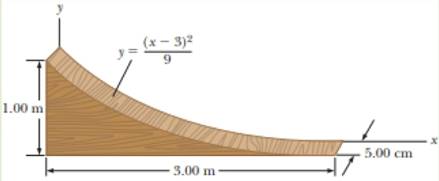
Concept explainers
Your brother is opening a skateboard shop. He has created a sign for his shop made from a uniform material and in the shape shown in Figure P12.5. The shape of the sign represents one of the hills in the skateboard park he plans on building on land adjacent to the shop. The curve on the top of the sign is described by the function y = (x − 3)2/9. When the sign arrives in his shop, your brother wants to hang it from a single wire outside the shop. But he doesn’t know where on the sign to attach the wire so that the bottom edge of the sign will hang in a horizontal orientation. He asks for your help.
Figure P12.5

Trending nowThis is a popular solution!

Chapter 12 Solutions
Bundle: Physics for Scientists and Engineers with Modern Physics, Loose-leaf Version, 10th + WebAssign Printed Access Card for Serway/Jewett's Physics for Scientists and Engineers, 10th, Multi-Term
- (a) What magnitude point charge creates a 90,000 N/C electric field at a distance of 0.235 m? 5.53e-7 C (b) How large is the field at 22.2 m? 9e4 Using the equation for the electric field due to a point charge, and knowing the charge from part (a), can you solve for the field? N/Carrow_forwardNo chatgpt pls will upvote Already got wrong chatgpt answerarrow_forwardNo chatgpt pls will upvotearrow_forward
- Taking a Hike A hiker begins a trip by first walking 21.0 km southeast from her car. She stops and sets up her tent for the night. On the second day, she walks 46.0 km in a direction 60.0° north of east, at which point she discovers a forest ranger's tower. y (km) Can N W-DE 45.0° 60.0° Tent Tower B x (km) ☹ (a) Determine the components of the hiker's displacement for each day. SOLUTION Conceptualize We conceptualize the problem by drawing a sketch as in the figure. If we denote the displacement vectors on the first and second days by A and B, respectively, and use the ---Select-- as the origin of coordinates, we obtain the vectors shown in the figure. The sketch allows us to estimate the resultant vector as shown. Categorize Drawing the resultant R, we can now categorize this problem as one we've solved before: --Select-- of two vectors. You should now have a hint of the power of categorization in that many new problems are very similar to problems we have already solved if we are…arrow_forwardPlz plz no chatgpt pls will upvote .arrow_forwardYou want to determine if a new material created for solar panels increases the amount of energy that can be captured . You have acquired 15 panels of different sizes manufactured with different materials including the new material.You decide to set up an experiment to solve this problem .What do you think are the 3 most important variables to address in your experience? How would you incorporate those materials in your experiment?arrow_forward
- 7. Are all scientific theories testable in the commonly understood sense? How does this make you feel? How should you proceed as a scientist or engineer with this understanding?arrow_forwardWhat is an an example of a hypothesis that sounds scientific but is notarrow_forwardWhat is an example of a scientific hypothesisarrow_forward
 Physics for Scientists and Engineers: Foundations...PhysicsISBN:9781133939146Author:Katz, Debora M.Publisher:Cengage Learning
Physics for Scientists and Engineers: Foundations...PhysicsISBN:9781133939146Author:Katz, Debora M.Publisher:Cengage Learning Principles of Physics: A Calculus-Based TextPhysicsISBN:9781133104261Author:Raymond A. Serway, John W. JewettPublisher:Cengage Learning
Principles of Physics: A Calculus-Based TextPhysicsISBN:9781133104261Author:Raymond A. Serway, John W. JewettPublisher:Cengage Learning Physics for Scientists and EngineersPhysicsISBN:9781337553278Author:Raymond A. Serway, John W. JewettPublisher:Cengage Learning
Physics for Scientists and EngineersPhysicsISBN:9781337553278Author:Raymond A. Serway, John W. JewettPublisher:Cengage Learning Physics for Scientists and Engineers with Modern ...PhysicsISBN:9781337553292Author:Raymond A. Serway, John W. JewettPublisher:Cengage Learning
Physics for Scientists and Engineers with Modern ...PhysicsISBN:9781337553292Author:Raymond A. Serway, John W. JewettPublisher:Cengage Learning Physics for Scientists and Engineers, Technology ...PhysicsISBN:9781305116399Author:Raymond A. Serway, John W. JewettPublisher:Cengage Learning
Physics for Scientists and Engineers, Technology ...PhysicsISBN:9781305116399Author:Raymond A. Serway, John W. JewettPublisher:Cengage Learning College PhysicsPhysicsISBN:9781285737027Author:Raymond A. Serway, Chris VuillePublisher:Cengage Learning
College PhysicsPhysicsISBN:9781285737027Author:Raymond A. Serway, Chris VuillePublisher:Cengage Learning





